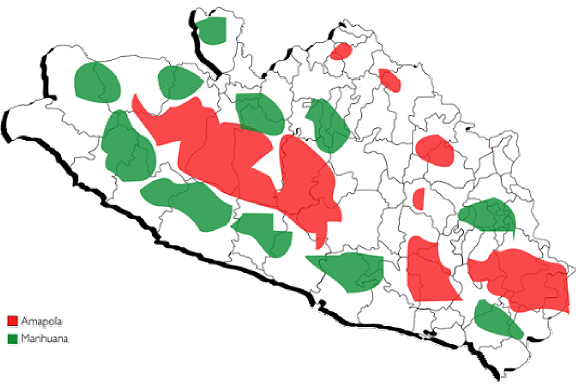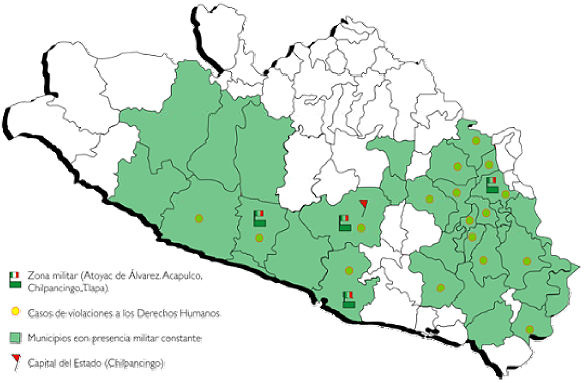S.I. 4 – Health
06/02/2012S.I. 6 – Natural Resources
06/02/2012S.I. 5 – Land
Land: a conflict of visions
The concept of land held by the indigenous peoples is different from that of the mestizo population. The indigenous peoples continue to view the land as whole and sacred (“mother earth”), to be held collectively and not for sale. In Mexico, ejidos and communal lands have been the dominant form of landholding:
- Ejidos: each ejidatario, member of the ejido, receives a parcel of land and all decisions pertaining to the ejidal land have to be made by the entire assembly of the ejidatarios.
- Communal Lands: the land belongs to all members of the community and, as a result, the benefits of the land are distributed among all members.
In Guerrero, 56.9% of the total surface area of workable land pertains to these two types of landownership:
- 1,514,459 hectares are ejidal lands (44.6%)
- 417,445 hectares are communal lands (12.3%)
Source: INEGI 2007
The indigenous vision of land is in conflict with another more commercial vision; within the current economic system, the land has been reduced to only its material value and, at various times, has been fragmented by authority of the law. The concept of private property arose and, with it, many agrarian problems.
Source: State Agency for the Development and Autonomy of the Indigenous Peoples of Guerrero, Tlachinollan A.C., May 2005
… … …
Legislation regarding the Land: Fragmentation and Privatization
Collective land ownership has been attacked at many times in Mexican history. At the end of the War for Independence, in 1856, the laws of confiscation prohibited communal ownership, ordered the division of communal lands and authorized the expedition of deeds for private property. In this way, in the Costa Chica and Montaña regions, the best lands were monopolized by plantation owners, who purchased supposed land deeds from local caciques (local political bosses), disregarding the rights of communal landholders.
While indigenous people may have managed to recover some of their lands following the Mexican Revolution, the 1992 reform of Article 27 of the constitution again allowed for the privatization of land. PROCEDE (Program of Certification of Ejidal Rights) and PROCECOM (Program of Certification of Communal Rights) were born of this reform.
Many civil organizations have denounced PROCEDE and PROCECOM for creating divisions in communities and ejidos and for spurring the sale and the monopolizing of collective lands. For example, when an ejido accepts PROCEDE, the campesinos can obtain credit, but in exchange they have to use their lands as collateral and, later, if they are unable to repay the loan, they lose their lands. In addition, when they enter into PROCEDE, they have to begin paying property taxes for their plot of land. Therefore, PROCEDE is seen by many as a neoliberal strategy waged against the indigenous community through the privatization of land.
Source : YORAIL MAYA #4, June 2002.
The way in which PROCEDE was “proposed” to people is also widely criticized. From its start in 1993, it was presented as a voluntary program. The Agrarian Department was accused of attempting to impose PROCEDE on all agrarian groups, pressuring and blackmailing communal and ejidal authorities, so that they take responsibility for informing people about and convincing them of the benefits of the program. In this way, it appeared that campesinos were freely choosing to privatize their lands and were therefore assuming responsibility for the consequences. In various places, the program was presented as a requirement for participating in other rural benefit programs, such as PROCAMPO.
Sources: State Agency for the Development and Autonomy of the Indigenous Peoples of Guerrero, Tlachinollan A.C., May 2005; State Forum “Our Word Made Path,” Tlachinollan, June 3-4, 2005
… … …
Agrarian Conflicts
According to the Agrarian Department, in January 2012, there were 50 open agrarian conflicts in Guerrero. Of these conflicts, 20 were considered “hot spots”. The state already has a high number of deaths, injuries, displacements and imprisonments due to conflicts over land, some of them dating back generations.
Agrarian conflicts arise for the following reasons:
- A lack of land ;
- Ambiguities and legislative loopholes regarding land rights and titles dating back decades and even centuries ;
- Plans for the land which are superimposed on previous plans, caused when agrarian authorities turn in altered documents ;
- Disagreements over territorial limits ;
- Land monopolies and illegal occupations by cattle farmers and loggers, who have the backing and protection of the authorities ;
- Inadequate or negligent responses from authorities in the resolution of these conflicts.
In the consecuences of agrarian disputes, more so in the prolonged ones, the XVI Report of the Tlachinollan Mountain Human Rights Center “Struggling to build the dawn of justice” (2011) stressed: “There are land disputes that have come to last between 2 and 6 years and this weakens the community, reducing the organizational capacity of the people: all efforts, all the capabilities that exist in these villages are aimed at enduring an agrarian conflict, at paying consultants, at paying the authorities for the travels or trips they may have to make. Instead of attending issues related to the development of their people or the defense of their territories against the greatest threats of mining, they are immersed in trying to solve a land conflict. “
One of the “hot spots” is for example the municipality of Zirándaro, in the Tierra Caliente region, where the communities of San Pedro and Garzas maintain a dispute over 2500 hectares of land with those of Puerto Grande. There have also been clashes in the limits of Oaxaca and Guerrero (Costa Chica) where inhabitants of Jicaral de Tovar (Oaxaca) and those of Jicayán (Guerrero) quarrel over land. In Marquelia, there is also a conflict among three groups for 300 hectares.


